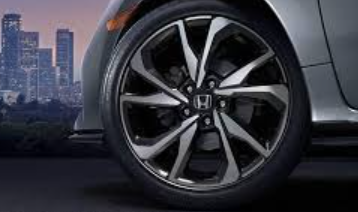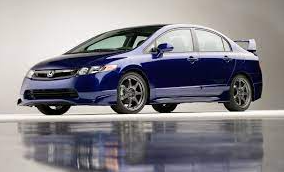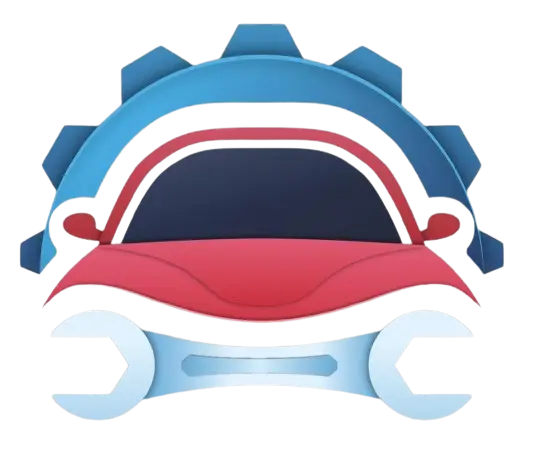Maintaining proper tire pressure is crucial for any car, and the 2008 Honda Civic is no exception. It not only affects your driving experience but also impacts fuel efficiency, tire wear, and overall safety.
This comprehensive guide dives deep into everything you need to know about tire pressure for your 2008 Civic, ensuring you navigate the roads with confidence and optimal performance.
Finding the Right PSI for Honda Civic 2008
First things first, identify the correct tire pressure for your specific Civic model and trim. Consult your owner’s manual or the tire placard (usually located inside the driver’s door jamb) for the recommended PSI (pounds per square inch).
| 2008 Civic 1.3H | |||
| Tire Size | Front Tire Pressure | Rear Tire Pressure | |
| 195/65 R15 89S | 32 psi | 32 psi | |
| 195/60 R16 90H | 29 psi | 29 psi | |
| 205/50 R17 90H | 30 psi | 30 psi | |
| 2008 Civic 2.0i | |||
| Tire Size | Front Tire Pressure | Rear Tire Pressure | |
| 215/45 R17 87V | 32 psi | 29 psi | |
| 215/45 ZR17 91W | 32 psi | 29 psi | |
| 225/40 ZR18 90W | 33 psi | 36 psi | |
| 2008 Civic 1.8i | |||
| Tire Size | Front Tire Pressure | Rear Tire Pressure | |
| 195/65 R15 89H | 30 psi | 29 psi | |
| 205/55 R16 89H | 32 psi | 32 psi | |
| 225/50 R16 91V | 30 psi | 30 psi |
Remember, these values are typically listed for both cold and hot tires. Cold tires refer to tires that haven’t been driven for at least 3 hours, while hot tires are after driving for more than 10 minutes.

Model Variations
Different 2008 Honda Civic models have varying tire pressure recommendations. Here’s a quick breakdown:
- LX/DX Sedan: 32 psi front, 33 psi rear (cold)
- EX/Si Sedan: 33 psi front, 35 psi rear (cold)
- Coupe: 32 psi all around (cold)
- Hybrid: 36 psi front, 35 psi rear (cold)

Seasonal Adjustments
Tire pressure fluctuates with temperature changes. During colder months, expect a slight decrease in pressure (around 1 psi for every 10°F drop).
Conversely, hot weather can cause pressure to rise. Consider adjusting your tire pressure accordingly to maintain optimal performance throughout the year.
Fuel Efficiency and Safety
Underinflated tires increase rolling resistance, leading to decreased fuel economy. Conversely, overinflated tires wear unevenly and can compromise handling and grip, impacting safety.
Maintaining the right tire pressure ensures optimal fuel efficiency and safe driving performance.
Tire Pressure Monitoring System (TPMS)
Most 2008 Civics come equipped with a TPMS that alerts you when tire pressure falls below a specific threshold. Don’t ignore these warnings! Check your tire pressure immediately and adjust accordingly.
Proactive Maintenance
Regularly checking your tire pressure (at least once a month) is essential. Remember to include the spare tire in your checks! Invest in a good quality tire pressure gauge for accurate readings.
Additional Tips
- Check tire pressure before long trips or when carrying heavy loads.
- Consider using nitrogen instead of regular air for slower pressure loss over time.
- Be aware of external factors like potholes or sharp objects that can damage your tires and affect pressure.
Conclusion
Maintaining proper tire pressure in your 2008 Honda Civic is more than just a routine task; it’s an investment in safety, fuel efficiency, and the longevity of your beloved car.
By adhering to the recommendations in this guide, you can navigate the roads with confidence, knowing your tires are performing at their peak.
Remember, even slight adjustments to PSI can make a significant difference, so prioritize regular checks and proactive maintenance. Now, hit the gas with the peace of mind that comes from optimal tire pressure!
FAQs
Q: What happens if I drive with underinflated tires?
Underinflated tires increase rolling resistance, leading to decreased fuel economy and uneven tire wear. They also compromise handling and grip, posing a safety risk.
Q: What happens if I drive with overinflated tires?
Overinflated tires can reduce traction and make your car more susceptible to punctures. They can also lead to premature tire wear in the center of the tread.
Q: How often should I check my tire pressure?
Aim to check your tire pressure at least once a month, including the spare tire. Consider more frequent checks during extreme weather conditions or before long trips.
Q: Can I use nitrogen instead of regular air in my tires?
Nitrogen inflated slower than regular air, leading to less fluctuation in pressure over time. While not essential, it can be a worthwhile option for some drivers.
Q: Where can I find the recommended tire pressure for my specific 2008 Civic model?
Always refer to your owner’s manual or the tire placard inside the driver’s door jamb for the recommended PSI for your specific model and trim.
Q: What resources are available for further information on tire pressure and maintenance?
Consult your local Honda dealership or trusted mechanic for professional advice. Additionally, the National Highway Traffic Safety Administration (NHTSA) website offers valuable resources on tire safety and maintenance.

